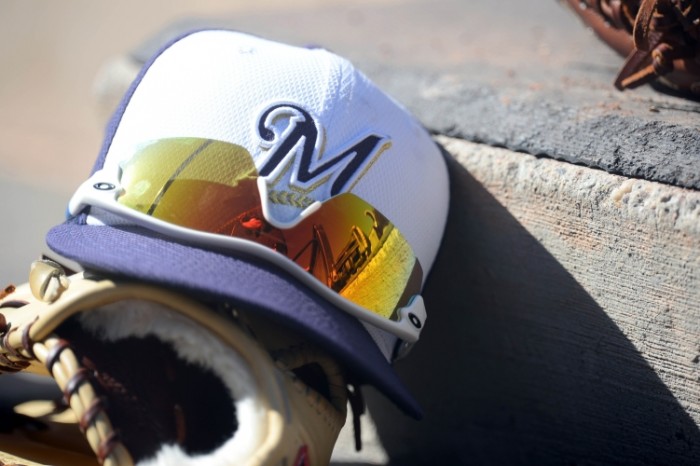When you’re following a rebuilding club, “Prospect List Day” is like a Holiday morning: it’s a chance to quantify some of the difficult aspects of future roster building that (by necessity) are not quantifiable. This is perhaps the most difficult part about rebuilding, and the BaseballProspectus team nails that in their report of the system. Although Milwaukee has indeed built one of the very best systems in the MLB — they join the Yankees, White Sox, and Atlanta to control 30 of the Top 101 prospects — it is also a volatile system, and reading through each prospect report will underscore that fact.
The BaseballProspectus list follows, and the subscription reports are certainly worth reading for each player. That digs into Overall Future Potential numbers, potential comparisons, and scouting field notes that make the BaseballProspectus list so extensive and worthwhile:
1. Lewis Brinson, OF [Acquired midseason 2016]
2. Josh Hader, LHP
3. Corey Ray, OF [Drafted in 2016]
4. Isan Diaz, SS [Acquired offseason 2015-2016]
5. Luis Ortiz, RHP [Acquired midseason 2016]
6. Brett Phillips, OF
7. Trent Clark, OF
8. Lucas Erceg, 3B [Drafted in 2016]
9. Mauricio Dubon, SS [Acquired offseason 2016-2017]
10. Cody Ponce, RHP
I added acquisition brackets to showcase how quickly GM David Stearns has added top tier talent to the Milwaukee system. It is undoubtable that former President Doug Melvin got the rebuilding ball rolling, including some of the success stories of 2016 (like Zach Davies, who ranks among the whole system’s Top Talent age-25 or younger). Yet, perhaps some of Doug Melvin’s (and, by extension, the late Bruce Seid’s) picks are lagging slightly behind in potential impact. For example, RHP Devin Williams is slowly developing, but has an excellent change up and a profile that many (like myself) are banking on breaking out. But, this assessment is not entirely fair, for Melvin’s administration has also developed Brandon Woodruff, who will look to build on a breakout 2016 campaign, and also features comeback candidates like RHP Jorge Lopez or OF Michael Reed. In fact, the Top Ten Age-25 talent list for the Brewers is currently split evenly between Melvin and Stearns, with the caveat that perhaps Stearns’s acquisitions leave more to dream on for the future simply because so many of Melvin’s top prospects have already graduated and therefore exposed their more realistic profiles (see Orlando Arcia as defensive wizard, Domingo Santana as Three True Outcome corner OF, or Zach Davies as [hopefully] perpetually outperforming that low-rotation scouting grade).
This is Stearns’s system now, and what jumps off the page from the reports is the potential well-rounded impact bats in the middle of the diamond. Catcher Jacob Nottingham is thus far only “interesting,” but when added to the mix of IF Mauricio Dubon, IF Isan Diaz, and OF Lewis Brinson, Stearns reveals a potential future roster depth that can anchor the middle of the diamond and seek big pricetag acquisitions elsewhere. One of the problematic aspects of the current Brewers prospect grouping is the in-between or corner profiles of outfielders such as Corey Ray, Trent Clark, and Brett Phillips. Ray’s likely left field stature puts ever more pressure on the high end of those batting projections to materialize, while both Clark and Phillips could potentially serve as fourth outfielders due to their abilities to counteract a move off centerfield with arms fit for right field. In terms of advanced arms like Ortiz and LHP Josh Hader, there is also quite a bit of range remaining in their potential roles, although Ortiz may have the more stable starting pitching profile should his innings workload and health trend upward. Hader should highlight the difficulty of taking OFP too seriously on prospect lists, but also the potential reward of doing so: the southpaw could serve as the headliner of the Brewers’ system promise and risk.
Either way, this is an exceptional step forward given that rebuilding began midseason 2015. Had Doug Melvin failed to take the first step, the organization would not be in this position now, and David Stearns has followed Melvin’s lead by adding true upside talent while effectively pricing out the risk of that talent. This is quickly becoming a farm system that will be able to consistently develop talent for the MLB roster and trades, hastening the Brewers’ ability to contend. 2017 will fittingly be more about the developmental side, as Brinson and Hader, among others, could leap to the MLB. Soon it will be their chance to prove that they can make the adjustments to reach their OFP.
